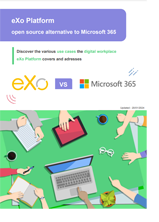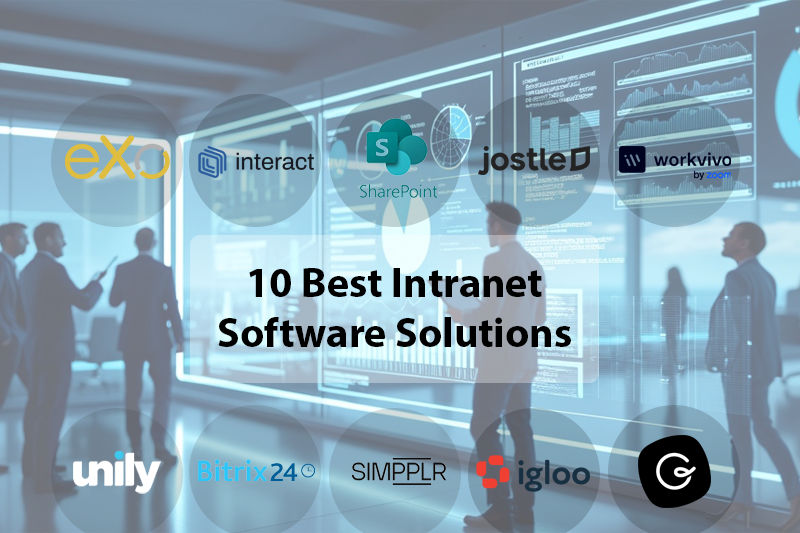- Benjamin Mestrallet
- June 9, 2008
eXo Platform: The Open Source alternative to Microsoft Sharepoint
Mircosoft Sharepoint might hit 1 Billion $ sales this year.
The growth is tremendous and there are quite some reasons for it: the lack of competition from other large vendors, the Microsoft direct and indirect sales force, the Microsoft Office integration and of course the organic growth strategy used for that product which makes it a perfect out of the box solution.
Coupled with Active Directory, Exchange and on the client side Vista as well as the Office suite, you have the entire Microsoft stack that rules your entire business.
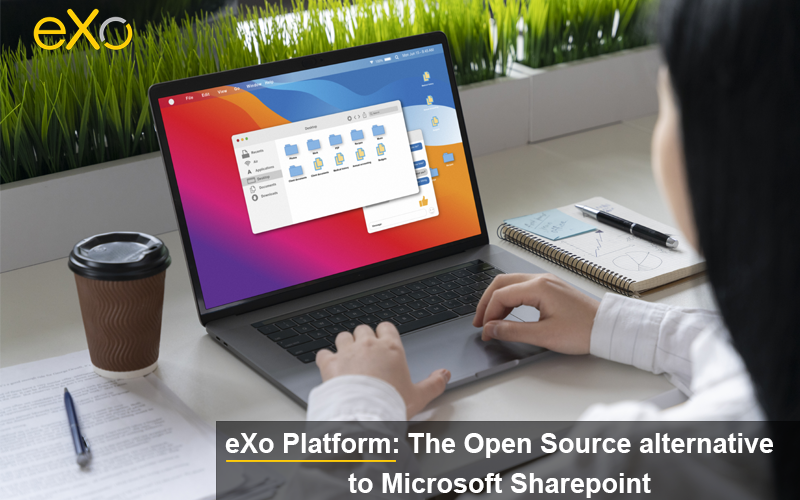
Content
BUT, being a 100% Microsoft shop is an extremely risky move that will tie your company to the Redmond firm for the next 10 years if not more. Many IT directors do not want to take the risk to see licenses price increase suddenly or being forced to upgrade to new products that would not fit their needs – like Vista or Silverlight.
“The most interesting thing about SharePoint is the way Microsoft is using it to get inside corporations, and once inside, to further their grip,” said Gartner Inc. analyst Mark Gilbert a bit like IBM used to do with its mainframes (well, it is still the case in fact).
1. Other majors IT vendors do not have a competitive offering:
- IBM: you will need Websphere Portal, FileNet and Lotus Notes / Domino to get the same set of features. First it is extremely expensive and it is also a poorly integrated stack that can not compete for new customers. If you also add the dependency on the application software and in many cases on the hardware you come up with a huge heavy stack.
- Oracle: here again you will need Oracle WebCenter, Stellent and Oracle Collaboration Suite (OCS) to compete, but once again it is not integrated at all…it is even worse than for the IBM stack as the portal chosen (among the 2 from Oracle and the 2 from BEA) is WebCenter while OCS is built on an older version of the Portal. Finally the identity provisioning in those 3 products is complex and data synchronization is needed.
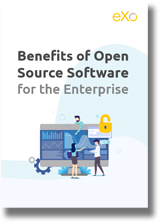
FREE WHITE PAPER
for the Enterprise
2. New comers DO NOT leverage the existing IT system
There also exist several new comers but none of them, in different ways really get the importance of leveraging existing IT infrastructure, to build on top of standards or open protocols:
- Google: yes, Google is a new comer into the Enterprise game but with its positioning it currently targets more the small enterprise that can afford to have their data hosted on the cloud. Moreover, it does not really care about the existing standards and tends to always create new de facto ones which makes the integration more complex into the company
- Many Web 2.0 vendors such as JiveSoftware, TBlox try to compete with Sharepoint with the usual Start Page look – a la NetVibes – and the social approach seeing it as the next big Enterprise software shift. This move is indeed something that will happen but the social part will be a cross cutting concern that will have to lay on top of the existing IT infrastructure.
3. Up to now, NO Open Source alternative
The Open Source world is big and spread over a multitude of small applications written in many different programmatic languages.
Up to now no solution was able to offer the same functional scope as Microsoft Sharepoint and users or IT integrators had to glue pure players application such as Liferay / Jboss Portal, Alfresco / Nuxeo and Zimbra to compete. But even if licenses costs were low, the maintenance cost of the overall solution for the entire lifetime of the solution would over pass the sharepoint Total Cost of Ownership (TCO).
Moreover, each applications having its independent road map, each upgrades of the solution tended to become a nightmare for the user and/or the IT integrator. To overcome those issues, Open Source vendors have tried, like Alfresco, to position itself as a Sharepoint competitor even if the functional scope was really far from the Sharepoint one (at the end, Alfresco is “just” a shared drive).
4. eXo Platform: The Open Source alternative
With the launch of eXo WebOS flagship product as the new type of Enterprise Portals and all its incoming optional modules such as eXo Enterprise Content Managment (eXo ECM) and eXo Collaboration Suite (eXo CS), we have been able to build the only true alternative to Microsoft Sharepoint.
But eXo Platform is not only a Sharepoint altrenative it goes much further:
- An Open Source solution: being Open Source for the application that is the entry point to your IT system is something that makes a lot of sense; being able to modify the solution to adapt it to your needs, profiling or security policies is a must. Open Source allows you to customize the software as you want and not only as the vendor wants.
- Based on Open Standards: we think that interoperability is even more important than being Open Source. Leveraging Open Standards is a must for an Enterprise Portal that will have to integrate with all your IT system and we all know this is not the strength of Microsoft products.
- Leveraging existing IT infrastructure: the JavaEE choice for the server side part of eXo Platform which for example allows the platform to be deployed on any application servers, to leverage administration and management solutions, or even to use the Java Connector Architecture components to communicate with mainframes and IT legacy. So, this allows to secure and leverage the big $ invested by the company. Hence, a new user interface to expose the information of older backend systems is available and will bring your IT to the next stage.
- Integrated Stack: the software we build is based on a platform strategy where a single core is used to plug services and applications on top of it to package dedicated products reusing the same components for all the products.
- Data Portability: this one is a side effect of being based on standards as we implement a specification from the Java Community Process (JCP) which allows us to structure data and meta-datas, to store them and more important to export them in a standard XML format.
- Application Portability: same as for the data portability, we have implemented another specification of the JCP which defines applications (called portlets) that can run in different portals such as the one of IBM or Oracle. In the incoming versions of our product, we will also support the Google gadgets along with our own widget API (that we developed before the launch of Open Social).
- Services exposure: exposing datas outside the platform is critical but being able to also expose business logic is even more important these days. Thanks to a REST framework built on top of a (in progresss) JCP specification it is possible to easily expose to anyone on the internet a set of API that could then be part of a mashup service hosted somewhere else on the internet.
- Microsoft Office AND Open Office Integration: documents stored inside eXo Document Management System can be remotely accessed inside Microsoft Office Suite thanks to an eXo plugin for Office developed using the .Net framework. It is also possible to compare versions or do advanced search of documents hosted on the server without moving from Mircrosoft Word. BUT, we also have developed the same kind of plugin for Open Office!
- Web 2.0, Social software and consumer habits moved into the enterprise: while Sharepoint has so far only tried to make older applications like Lotus or Websphere Portal more accessible in the enterprise, they have not yet pushed into the enterprise the new type of software we have seen with the rising of Web 2 services out there. Bringing Web 2.0 technology and methodology into the enterprise to make it more collaborative and user friendly is an important goal of the eXo mission.
- AN OS INSIDE THE BROWSER: finally but NOT LEAST, our revolutionary user interface that reproduces a multi-window environment inside the browser. Normal users may not understand why there is an OS inside the browser BUT it naturally eases the use of web applications and allows EVERYONE in the enterprise to move to the next generation of applications: rich web application based on standards. And we will keep that huge competitive advantage as for sure Microsoft will not go that way OTHERWISE it will kill its cash cow Vista product and will make its Software + Service strategy completely useless and outdated…
eXo Platform and its new modules is truly the only alternative to Microsoft Sharepoint.
We have done a HUGE amount of work to build this platform from the ground and to bootstrap the company. Thanks to our early adopter customers who are really large organizations and companies, we were able to validate the solution. There is quite some work left but we did the most difficult part of it. It has not been easy all the time but we can all be proud of the work we have achieved so far.
All together, we will avoid a new monopoly!
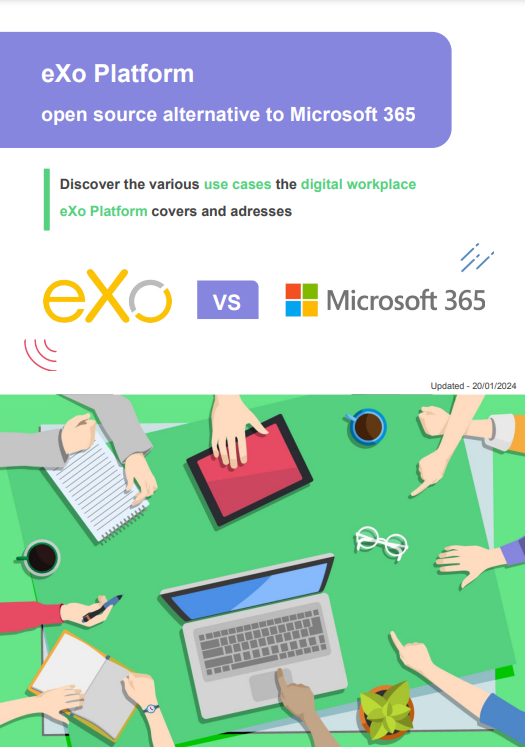
FREE WHITE PAPER
Open Source Alternative to Microsoft 365
Empower your organization with eXo Platform to break free from Microsoft dependencies and enhance collaboration with innovative solutions
- Tags: eXo, Open source, Industry trends
Related posts
- All
- eXo
- Digital workplace
- Employee engagement
- Open source
- Future of work
- Internal communication
- Collaboration
- News
- intranet
- workplace
- Knowledge management
- Employee experience
- Employee productivity
- onboarding
- Employee recognition
- Change management
- Cartoon
- Digital transformation
- Infographic
- Remote work
- Industry trends
- Product News
- Thought leadership
- Tips & Tricks
- Tutorial
- Uncategorized
Leave a Reply
( Your e-mail address will not be published)
